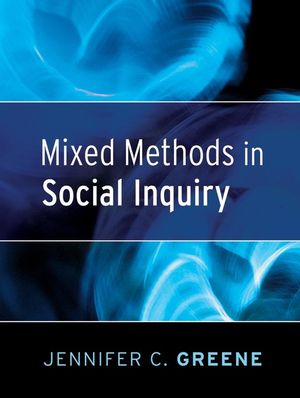|
Textbook
Mixed Methods in Social InquiryISBN: 978-0-7879-8382-6
Paperback
240 pages
October 2007, ©2008, Jossey-Bass
 |
||||||
List of Tables, Figures, and Exhibits ix
Introduction xi
The Author xv
Part One 1
Chapter One: Mental Models and Mixed Methods Inquiry 3
Group Discussion 5
Making Sense of These Conversations: The Concept of Mental Models 11
Mixed Methods Social Inquiry as Mixing Mental Models 13
An Invitation to Read This Book 14
Who is Invited 16
Chapter Two: Adopting a Mixed Methods Way of Thinking 17
A Mixed Methods Way of Thinking 20
Looking Ahead 30
Chapter Three: The Historical Roots of the Contemporary Mixed Methods Conversation 31
The Philosophical Seeds of Discontent 33
The Seeds of Discontent in Practice 35
The Great Qualitative-Quantitative Debate 36
Rapprochement and the Emergence of the Idea of Mixing Methods 42
But Troubled Waters Remained 48
Chapter Four: Contested Spaces: Paradigms and Practice in Mixed Methods Social Inquiry 49
On the Nature of Philosophical Paradigms for Social Inquiry, and Mental Models, Too 51
Interlude 54
On the Relationships of Mental Models (and Paradigms) to Practice 55
A Reflective Stance 59
My Mixed Methods Story 60
Chapter Five: Stances on Mixing Paradigms and Mental Models While Mixing Methods 66
Various Stances on Mixing Paradigms While Mixing Methods— An Overview 67
Reprise 86
Interlude One: An Illustration of A Mixed Methods Way of Thinking 88
Study Purpose 89
Mixed Methods Research Design 89
Mixed Methods Analysis 91
Sample Results 91
Part Two 93
Chapter Six: Mixing Methods on Purpose 95
Mixing Methods for Better Understanding 98
Purposes for Mixing Methods 98
An Illustration of Mixed Methods Purposes in Practice 104
Practical Procedures for Thinking About and Identifying Mixed Methods Purposes 107
Mixed Methods Purposes and Stances on Mixing Paradigms While Mixing Methods 109
Chapter Seven: Designing Mixed Methods Studies 112
Mixing Methods at Different Stages of Social Inquiry: Mixed Methods and Mixed Model Designs 113
Mixing Methods With in a Single Study or Across Studies in a Program of Research 117
Dimensions of Difference in Mixed Methods Design 118
Component and Integrated Mixed Methods Designs 120
Other Formulations of Mixed Methods Design 129
Illustrations of Mixed Methods Designs in Practice 132
Connecting Mixed Methods Designs to Mixed Methods Paradigm Stances and Mixed Methods Purposes 134
Interlude Two: Mixed Methods Purposes and Designs in Action 138
Overall Mixed Methods Purposes and Design 139
Mixed Methods Contributions to the MTO Study 141
Chapter Eight: Mixed Methods Data Analysis 142
Thinking About Mixed Methods Data Analysis 143
Mixed Methods Data Analysis Strategies 144
Mixed Methods Data Analysis Exemplars 155
Reprise 163
Chapter Nine: Judging the Quality of Mixed Methods Social Inquiry 164
Thinking About Inquiry Criteria in Mixed Methods Social Inquiry 165
Inference Quality in Mixed Methods Social Inquiry 167
Legitimation as Quality in Mixed Methods Social Inquiry 168
Warranting the Quality of Inferences in Mixed Methods Inquiry 169
An Illustration 174
Chapter Ten: Writing Up and Reporting Mixed Methods Social Inquiry 179
Writing Up Mixed Methods Social Inquiry 181
Representation in Social Inquiry 182
Writing up Mixed Methods Social Inquiry: Two Preliminary Principles 185
Interlude Three: More Creativity in Mixed Methods Data Analysis and Display 189
The Metaphor 189
The Example 190
An Application of the Archipelago Metaphor 191
Part Three 193
Chapter Eleven: The Potential and Promise of Mixed Methods Social Inquiry 195
References 200
Index 210



